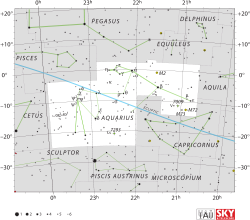Top Qs
Timeline
Chat
Perspective
53 Aquarii
Binary star in the constellation Aquarius From Wikipedia, the free encyclopedia
Remove ads
53 Aquarii (abbreviated 53 Aqr) is a binary star[12] system in the equatorial constellation of Aquarius. 53 Aquarii is its Flamsteed designation though the star also bears the Bayer designation of f Aquarii. The combined apparent visual magnitude of the pair is a 5.56,[2] making it just visible to the naked eye in dark suburban skies. Based upon an annual parallax shift of 49.50 milliarcseconds for the first component, this system is located at a distance of approximately 65 light-years (20 parsecs) from Earth.[1]
This is a wide binary star system with a projected separation of 100 astronomical units; indicating that the two stars are at least this distance apart.[8] The primary component is a solar-type main sequence star with a stellar classification of G1 V.[4] It has about 99% of the Sun's mass, 111% of the Sun's radius, and shines with 139% of the luminosity of the Sun.[8] This energy is being emitted from an outer envelope at an effective temperature of 5,922 K,[3] giving it the golden hue of a G-type star.[13] An examination of the primary component with the Spitzer Space Telescope failed to detect any infrared excess that might otherwise be an indication of a circumstellar debris disk.[8]
The companion is a slightly cooler star with an effective temperature of 5,811 K.[3] It has a stellar classification of G5 V Fe–0.8 CH–1,[4] indicating it is a chemically peculiar G-type main sequence star showing an under-abundance of iron and the molecule CH in its spectrum. As of 2008, it has an angular separation of 1.325 arcseconds along a position angle of 30.9° from the primary.[14]
This system is coeval with the Castor Moving Group of stars that share a common motion through space; hence it is a candidate member of that association. This suggests that the system is young; its estimated age is in the range of 180 to 370 million years, based upon the spectrum and X-ray luminosity, respectively.[10]
Remove ads
References
Wikiwand - on
Seamless Wikipedia browsing. On steroids.
Remove ads

